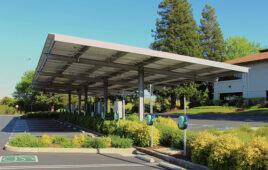PG&E and BMW of North America are working together on vehicle-to-everything (V2X) technology testing. The V2X testing is taking place at PG&E’s Applied Technology Services (ATS) Lab in San Ramon, California, and is the focal point of an extended partnership to advance V2X technology and explore the utilization of EVs as a flexible grid resource. The collaborative testing builds on the momentum of the ChargeForward smart charging program, which was announced in 2015 and offers PG&E customers who drive a BMW EV incentives to align vehicle charging with renewable energy to support the overall sustainability of the electric grid.
 “Electric grid sustainability is becoming an increasingly complex challenge across the U.S.,” said Adam McNeill, VP of Engineering, BMW of North America. “That’s why we started our ChargeForward program in 2015, to connect our vehicles, our customers, and the grid. V2X takes smart charging to the next level, exploring how EV batteries can be used for backup generation and other grid services. We’re excited to continue pursuing additional customer benefits while helping make the grid more dependable and sustainable.”
“Electric grid sustainability is becoming an increasingly complex challenge across the U.S.,” said Adam McNeill, VP of Engineering, BMW of North America. “That’s why we started our ChargeForward program in 2015, to connect our vehicles, our customers, and the grid. V2X takes smart charging to the next level, exploring how EV batteries can be used for backup generation and other grid services. We’re excited to continue pursuing additional customer benefits while helping make the grid more dependable and sustainable.”
V2X technology uses bidirectional EV chargers to allow EV drivers to return excess stored energy from their vehicle batteries back to the grid in exchange for compensation.
“The utility and automotive industries are creating a transformative clean energy future together. At PG&E we are working with partners like BMW to unleash the full potential of EVs to enhance grid resilience and reliability for our customers, while reducing carbon emissions in our hometowns” said Aaron August, PG&E Vice President, Utility Partnerships and Innovation. “Clean-powered EVs are vital to the battle against climate change. Using V2X technology to create virtual power plants from EVs can help utilities like ours meet peak electricity demand without the need for non-renewable energy resources. With smart, managed bi-directional charging, we can decarbonize our planet at a lower cost to our customers.”
The pilot is assessing how a typical home could maximize its renewable energy usage by switching between EV battery stored power and grid-provided power. The EV battery charges when the renewable energy mix on the grid is highest and the battery discharges throughout the day to support the household load. Results show that a vehicle-to-home connected EV is capable of providing roughly double the amount of renewable energy that a typical California household would be able to use on an average day, significantly increasing customers’ ability to use more green energy on a daily basis. Testing also offers insights on how V2X vehicles perform under real-world scenarios, taking into consideration vehicle functionality and driver behavior to ensure that EVs can be used as a viable grid resource while still meeting customer needs.
PG&E and BMW will continue collaborating to better understand how these learnings can be applied to consider other customer and utility benefits.
News item from BMW





Tell Us What You Think!